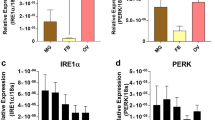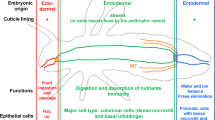Summary
Accessory glands of the cockroach are composed of secretory and supportive cells, the latter providing a skeleton-like framework of attentuated cytoplasmic processes into which the former are positioned. These two cell types are associated with one another laterally by adhaering, pleated septate, and gap junctions. Hemi-adhaerens junctions are also found on both luminal and basal surfaces of the gland; the former are associated with the cuticular lining of the lumen and the latter with extracellular matrix. The adhering and septate junctions are flanked by both filaments and microtubules; the former insert into the junctional membranes and are actin-like, binding both rhodamine-conjugated phalloidin and the S1 subfragment of rabbit heavy meromyosin. The role of this cytoskeletal protein with the cellular junctions has been explored by treatment with a disruptive agent, cytochalasin D. Dissociation of actin leads to changes in septate junctions and in microtubular distribution. This suggests that the latter act as anchors for the actin filaments which, in turn, appear bound to certain of the intramembranous junctional components.
Similar content being viewed by others
References
Ashhurst DE (1970) An insect desmosome. J Cell Biol 46:421–425
Barbier R (1975) Differenciation de structures ciliares et mise en place des canaux au cours de l'organogénèse des glands colletériques de Galleria mellonella L. (Lepidoptère, Pyralide). J Microsc 24:315–326
Bonnanfant-Jais M-L (1974) Morphologie de la glande lactée d'une Glossine, Glossina austeni Newst, au cours du cycle de gestation. J Microsc 19:265–284
Crossley AC, Waterhouse DF (1969) The ultrastructure of a pheromone-secreting gland in the male scorpion-fly Harbobittacus australis (Bittacidae, Mecoptera). Tissue Cell 1:273–294
Dallai R, Marchini D, Callaini G (1989) Microtubule and microfilament distribution during the secretory activity of an insect gland. J Cell Sci 91:563
Finbow ME, Buultjens TEJ, Lane NJ, Shuttleworth J, Pitts JD (1984) Isolation and characterisation of arthropod gap junctions. EMBO J 3:2271–2278
Flower NE (1972) A new junctional structure in the epithelia of insects of the order Dictyoptera. J Cell Sci 10:683–691
Franke WW, Cowin P, Schmelz M, Kapprell H-P (1987) The desmosomal plaque and the cytoskeleton. In: Junctional complexes of epithelial cells. Ciba Foundation Symposium 125, Chichester, John Wiley and Sons, pp 26–48
Garrod DR (1986) Desmosomes, cell adhesion molecules and the adhesive properties of tissue cells. J Cell Sci [Suppl] 4:221–237
Geiger B (1989) Cytoskeleton-associated cell contacts. Current opinion in Cell Biology 1:103–109
Geiger B, Avmer Z, Volberg T, Volk T (1985) Molecular domains of adherens junctions. Chap. 21 In: Edelman G, Thiery J-P (eds) The cell in Contact. New York, John Wiley and Sons
Geiger B, Volk T, Bendori R (1987) Molecular interactions in adherens-type contacts. J Cell Sci 8:251–272
Green CR (1978) Variations of septate junction structure in the invertebrates. In: Sturgess JM (ed) Electron microscopy, Proc 9th Int Congress Electron Microscopy, Toronto, Canada, Imperial Press, pp 338–339, vol 2
Green CR, Bergquist PR (1982) Phylogenetic relationships within the invertebrata in relation to the structure of septate junctions and the development of ‘occluding’ junctional types. J Cell Sci 53:279–305
Green CR, Severs N (1984) Connexon rearrangement in cardiac gap junctions: Evidence for cytoskeletal control? Cell Tissue Res 237:185–186
Green CR, Noirot-Timothee C, Noirot C (1983) Isolation and characterization of invertebrate smooth septate junctions. J Cell Sci 62:351–370
Happ GM, Happ CM (1973) Fine structure of the pygidial glands of Bledius mandibularis (Coleoptera; Staphylinidae). Tissue Cell 5:215–231
Ishikawa H, Bischoff R, Holtzer H (1969) Formation of arrowhead complexes with heavy meromyosin in a variety of cell types. J Cell Biol 43:312–328
Keller TCS, Mooseker MS (1982) Ca2+-calmodulin-dependent phosphorylation of myosin and its role in brush border contraction in vitro. J Cell Biol 95:943–959
Lane NJ (1986) Arthropod fine structure: towards an understanding of the intricacies of intercellular junctions. Micron and Microscopica Acta 17:137–147
Lane NJ, Dallai R, Martinucci GB, Burighel P (1987) Cell junctions in Amphioxus (Cephalochordata); a thin section and freeze-fracture study. Tissue Cell 19:399–411
Lane NJ, Dilworth SM (1987) Isolation of septate junctions from insect and crustacean tissues: Differences between pleated and smooth varieties. J Cell Biol 105:226A
Lane NJ, Dilworth S (1989) Isolation and biochemical characterization of septate junctions. Differences between the proteins in smooth and pleated varieties. J Cell Sci 93:123–131
Lane NJ, Finbow M (1988) Isolation of gap and septate junctions from arthropod tissues. J Cell Biol 107:793
Lane NJ, Flores V (1988) Actin filaments are associated with the septate junctions of invertebrates. Tissue Cell 20:211–217
Lane NJ, Swales LS (1982) Stages in the assembly of pleated and smooth septate junctions in developing insect embryos. J Cell Sci 56:245–262
Lane NJ, Skaer H, Le B (1980) Intercellular junctions in insect tissues. Adv Insect Physiol 15:35–213
Lococco D, Huebner E (1980) The ultrastructure of the female accessory gland, the cement gland, in the insect Rhodnius prolixus. Tissue Cell 12:557–580
Loewenstein WR (1977) Permeability of the junctional membrane channel. In: Brinkley BR, Porter KR (eds) International Cell Biology. New York, Rockefeller University Press, pp 70–82
Madara JL, Barenberg D, Carlson S (1986) Effects of cytochalasin D on occluding junctions of intestional absorptive cells: further evidence that the cytoskeleton may influence paracellular permeability and junctional charge selectivity. J Cell Biol 102:2125–2136
Maupin P, Pollard TD (1986) Arrangement of actin filaments and myosin-like filaments in the contractile ring and of actin-like filaments in the mitotic spindle of dividing He La cells. J Ultrastruct Mol Struct Res 94:92–103
Meza I, Ibarra G, Sabanero M, Martinez-Palomo A, Cereijido M (1980) Occluding junctions and cytoskeletal components in a cultured transporting epithelium. J Cell Biol 87:746–754
Noirot C, Quenneday A (1974) Fine structure of insect epidermal glands. Ann Rev Entomol 19:61–80
Noirot C, Smith DS, Cayer ML, Noirot-Timothee C (1979) The organization and isolating function of insect rectal sheath cells: a freeze-fracture study. Tissue Cell 11:325–336
Noirot-Timothee C, Noirot C (1980) Septate and scalariform junctions in arthropods. Int Rev Cytol 63:97–140
Polak-Charcon S, Ben-Shaul Y (1979) Degradation of tight junctions in HT29, a human colon adenocarcinoma cell line. J Cell Sci 35:393–402
Roots BI (1978) A phylogenetic approach to the anatomy of glia. In: Schoffeniels E (ed). Dynamic properties of glial cells. Pergamon Press, New York, pp 45–54
Ryerse JS (1986) Isolation and characterisation of gap junctions from Drosophila. J Cell Biol 103:74A
Ryerse JS (1989) Isolation and characterization of gap junctions from Drosophila melanogaster. Cell Tissue Res 256:7–16
Skaer H, Le B, Maddrell SHP, Harrison JB (1987) The permeability properties of septate junctions in Malpighian tubules of Rhodnius. J Cell Sci 88:251–265
Swales LS (1985) Glial cell contacts in insects: effects of feeding on intercellular junctions. Tissue Cell 17:841–852
Tadvalkar, Pinto da Silva P (1983) In vitro rapid assembly of gap junctions is induced by cytoskeletal disruptors. J Cell Biol 96:1279–1287
Uyeda TQP, Furuya M (1989) Evidence for active interactions between microfilaments and microtubules in myxcomycete flagellates. J Cell Biol 108:1727–1735
Wood RL (1959) Intercellular attachment in the epithelium of Hydra as revealed by electron microscopy. J Biophys Biochem Cytol 6:343–352
Author information
Authors and Affiliations
Additional information
Supported by a Conicet/Royal Society Visiting Fellowship
Rights and permissions
About this article
Cite this article
Lane, N.J., Flores, V. The role of cytoskeletal components in the maintenance of intercellular junctions in an insect. Cell Tissue Res 262, 373–385 (1990). https://doi.org/10.1007/BF00309892
Accepted:
Issue Date:
DOI: https://doi.org/10.1007/BF00309892




